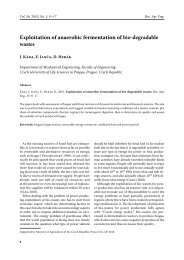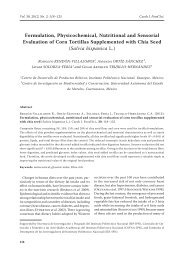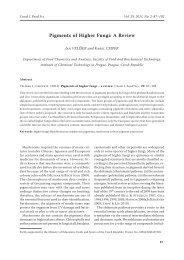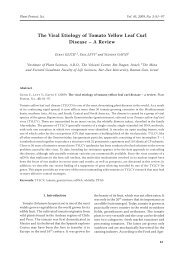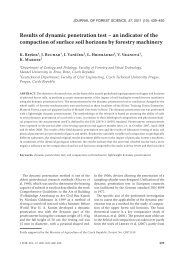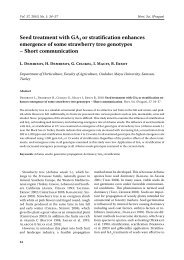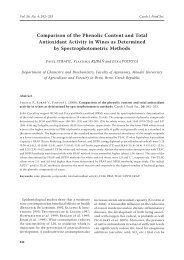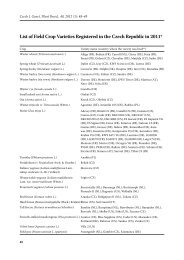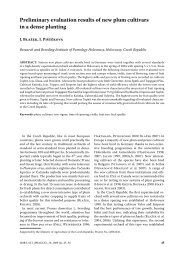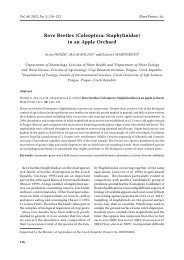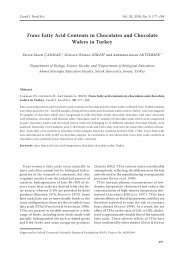Efficacy loss of strobilurins used in protection against apple scab in ...
Efficacy loss of strobilurins used in protection against apple scab in ...
Efficacy loss of strobilurins used in protection against apple scab in ...
Create successful ePaper yourself
Turn your PDF publications into a flip-book with our unique Google optimized e-Paper software.
Vol. 40, 2013, No. 2: 45–51<br />
Hort. Sci. (Prague)<br />
430 kg what presents 0.3% from <strong>of</strong> 148.8 t <strong>of</strong> total<br />
consumption <strong>of</strong> fungicides <strong>used</strong> <strong>in</strong> fruit plants <strong>protection</strong><br />
<strong>in</strong> the Czech Republic. In five years period<br />
from 2007–2011, the total <strong>strobilur<strong>in</strong>s</strong> consumption<br />
was relatively stabilised. Strobilur<strong>in</strong>s belong<br />
to important class <strong>of</strong> fungicides <strong>in</strong> plant <strong>protection</strong><br />
aga<strong>in</strong>st many phytopathogenic fungi. They have<br />
been successfully <strong>used</strong> <strong>in</strong> Europe to control the <strong>apple</strong><br />
<strong>scab</strong> s<strong>in</strong>ce 1998. They are known as Qu<strong>in</strong>one<br />
outside Inhibitors (QoI) <strong>in</strong>fluenc<strong>in</strong>g respiration<br />
pathway controlled by cytb gene (Bartlett et al.<br />
2002). Mode <strong>of</strong> action <strong>of</strong> benzimidazoles affects<br />
mitotic processes and cytoskeletal development<br />
(Davidse 1986). Because the mode <strong>of</strong> action <strong>of</strong><br />
both groups is highly specific, the risk <strong>of</strong> pathogen<br />
resistance is generally very high; and really<br />
resistance <strong>of</strong> V. <strong>in</strong>aequalis to both <strong>of</strong> groups was<br />
developed with<strong>in</strong> two years <strong>of</strong> <strong>in</strong>tensive use. While<br />
benzimidazoles are not registered for <strong>protection</strong><br />
aga<strong>in</strong>st the <strong>scab</strong> <strong>in</strong> the Czech Republic, presently<br />
<strong>strobilur<strong>in</strong>s</strong> are registered for wide use <strong>in</strong> many<br />
crops. In contrast, fungicides with more than one<br />
target site <strong>in</strong> the fungal cell have been <strong>used</strong> for<br />
more than 30 years before the resistant isolates<br />
have been found (Deis<strong>in</strong>g et al. 2008). Key cytb<br />
gene mutation G143A caus<strong>in</strong>g very high resistance<br />
<strong>of</strong> V. <strong>in</strong>aequalis to <strong>strobilur<strong>in</strong>s</strong> described Zheng et<br />
al. (2000). Mutant allele E198A <strong>of</strong> the beta-tubul<strong>in</strong><br />
(beta-tub) gene l<strong>in</strong>ked to high level <strong>of</strong> resistance<br />
to benomyl identified Koenraadt et al. (1992).<br />
The speed <strong>of</strong> mutants’ propagation depends on the<br />
pathogen biology as well as the number <strong>of</strong> fungicide<br />
applications per season (Sierotski et al. 2000;<br />
Barr et al. 2005; Lesemann et al. 2006; Chen et al.<br />
2007). Last research objectives lead to develop<strong>in</strong>g<br />
<strong>of</strong> different detection techniques for monitor<strong>in</strong>g <strong>of</strong><br />
causal mutations (Michalecka et al. 2011).<br />
The ma<strong>in</strong> objective <strong>of</strong> this study was to evaluate<br />
frequency <strong>of</strong> G143A and E198A mutations, to br<strong>in</strong>g<br />
the <strong>in</strong>formation about dispersion <strong>of</strong> mutants <strong>in</strong> orchards<br />
<strong>in</strong> the Czech Republic and <strong>in</strong>form about<br />
potential risk <strong>of</strong> <strong>strobilur<strong>in</strong>s</strong> use <strong>in</strong> <strong>apple</strong> grow<strong>in</strong>g<br />
systems.<br />
Table 1. Parameters <strong>of</strong> <strong>used</strong> primers<br />
MATERIAL AND METHODS<br />
Obta<strong>in</strong><strong>in</strong>g and cultivation <strong>of</strong> V. <strong>in</strong>aequalis isolates.<br />
In total 136 cultures <strong>of</strong> V. <strong>in</strong>aequalis from<br />
26 localities <strong>in</strong> the Czech Republic were collected and<br />
analysed <strong>in</strong> years 2007–2011. Isolates were collected<br />
<strong>in</strong> both <strong>scab</strong> resistant cultivars affected by pathogen<br />
<strong>scab</strong> races and chemically treated orchards <strong>of</strong> <strong>scab</strong><br />
susceptible cultivars where the <strong>strobilur<strong>in</strong>s</strong> efficacy<br />
<strong>loss</strong> was repeatedly reported. Also isolates from never<br />
treated trees were obta<strong>in</strong>ed. Conidia from sporeform<strong>in</strong>g<br />
lesions <strong>of</strong> <strong>in</strong>fected leaves were transferred to<br />
Petri dish with 2% Water Agar medium (Fluka, Sigma<br />
Aldrich, Seelze, Germany) and spread on the surface<br />
by dry sterile glass stick. After 48 h <strong>in</strong>cubation <strong>in</strong><br />
22 ± 2°C germ<strong>in</strong>ated conidia were found under microscope<br />
and transferred to 4% Chloramphenicol Yeast<br />
Glucose Agar (HIMEDIA, Mumbai, India) to avoid<br />
undesirable contam<strong>in</strong>ation. Cultures were ma<strong>in</strong>ta<strong>in</strong>ed<br />
alternately on 3.9% PDA (Potato Dextrose Agar, HI-<br />
MEDIA) and 4% Malt Extract Agar (HIMEDIA).<br />
Test <strong>of</strong> conidia germ<strong>in</strong>ation and mycelial<br />
growth <strong>in</strong> kresoxim-methyl. Conidia germ<strong>in</strong>ation<br />
was tested <strong>in</strong> 80 ml drops <strong>of</strong> 0.02% (w/v) solution<br />
<strong>of</strong> kresoxim-methyl (KM) fungicide Discus (BASF,<br />
Ludwigshafen, Germany). Rate <strong>of</strong> spores’ germ<strong>in</strong>ation<br />
<strong>in</strong> drops <strong>of</strong> tap water was <strong>used</strong> as control. Conidial<br />
suspensions were <strong>in</strong>cubated at the dip slides at<br />
22 ± 2°C for 48 h <strong>in</strong> the daylight. After <strong>in</strong>cubation<br />
500 <strong>of</strong> conidia were counted per sample. Each conidium<br />
produc<strong>in</strong>g the germ 1.5 times longer than the<br />
length <strong>of</strong> a spore was evaluated as germ<strong>in</strong>at<strong>in</strong>g. For<br />
each sample the Relative Conidia Germ<strong>in</strong>ation (RCG)<br />
was calculated. RCG = % <strong>of</strong> germ<strong>in</strong>at<strong>in</strong>g conidia <strong>in</strong><br />
KM × 100/% <strong>of</strong> germ<strong>in</strong>at<strong>in</strong>g conidia <strong>in</strong> tap water.<br />
In mycelial growth assay 20 monosporic mycelial<br />
plugs (2–3 mm 2 ) <strong>of</strong> each isolate were transferred<br />
from seven days old PDA culture to PDA plates<br />
supplemented with 0.2 g/l <strong>of</strong> the Discus and simultaneously<br />
on control plates without fungicide<br />
supplement. Fungicide was added after PDA sterilization<br />
<strong>in</strong>to fluid medium at 40°C. Plates were <strong>in</strong>cubated<br />
for 21 days at 22 ± 2°C <strong>in</strong> the daylight. The<br />
Gene Primer Sequence 5'–3' T m<br />
(°C) Position <strong>in</strong> gene Length (bp) F<strong>in</strong>al analysis<br />
cytb<br />
VB4F<br />
VB4R<br />
tgcaagataaatctgagttgacg<br />
tgttgttaggctcttcaatgaataat<br />
58 5390–5547 exon 4 158 SSCP<br />
beta-tub<br />
T6IIF<br />
T6IIR<br />
ctccaagattcgcgagga<br />
tggataagattgttagcaggtgtg<br />
58 1218–1767 exon 6 550 BstUI<br />
SSCP – ssDNA conformation polymorphism detect<strong>in</strong>g method<br />
46



